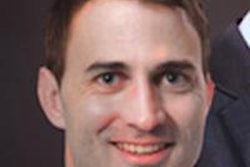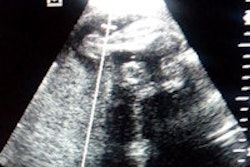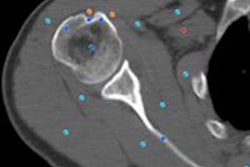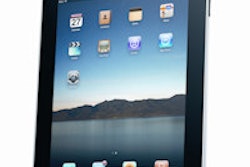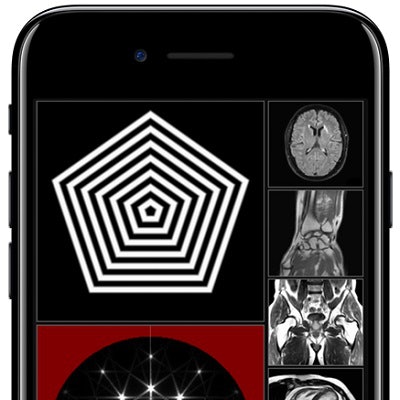
AuntMinnie.com presents the next article in an ongoing series highlighting notable mobile apps in radiology. In this installment, we take a look at A k-Space Odyssey, an iOS app designed to facilitate understanding of k-space, the mathematical abstraction that connects MRI scan parameters with the clinical image. With the app, users can adjust MR scan parameters and immediately see the effect of those changes on clinical images.
To learn more about A k-Space Odyssey, we chatted recently with the app's developer, Eltjo Haselhoff, PhD, product marketing manager for MRI at Philips Healthcare. Haselhoff developed the app in his spare time.
 Eltjo Haselhoff, PhD, product marketing manager for MRI at Philips.
Eltjo Haselhoff, PhD, product marketing manager for MRI at Philips.AuntMinnie: What inspired you to create this app?
Haselhoff: This app goes back more than 20 years ago, when I had just started my first job in MRI. To better understand the intricacies of what MR physicists call k-space, I wrote a simple program for the PC. It allowed me to adjust basic MR scan parameters, such as scan percentage and field-of-view, and immediately see the result on the corresponding MR image. Just playing about with this program turned out to be extremely insightful, and it helped me significantly to understand the concepts of MRI scanning in great depth.
I shared the program with friends, and it found its way to several universities where it was soon embraced as a teaching tool for students. Interestingly, I recently learned that even after all these years, the original program is still being used for the [cardiac MR] courses at Leeds University in the U.K.! Two years ago, I was fascinated by the incredible advances in smartphone technology and decided to learn iOS programming, which became one of my spare-time activities. And since to my knowledge no one had ever made a new version of my original MRI simulator, it ended up high on my to-do list.
What problem does the app solve or make easier to handle?
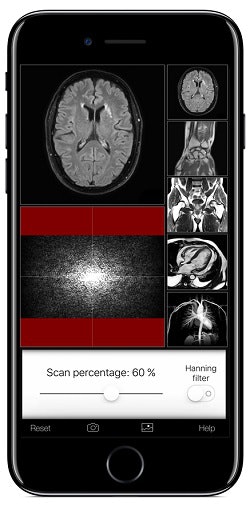 A k-Space Odyssey allows users to change MRI scan parameters such as scan percentage and see the effect on the MR image. All images courtesy of Eltjo Haselhoff, PhD.
A k-Space Odyssey allows users to change MRI scan parameters such as scan percentage and see the effect on the MR image. All images courtesy of Eltjo Haselhoff, PhD.This app helps you understand complex aspects of MRI. MRI is a complex technology because, unlike other medical imaging modalities such as ultrasound, x-ray, or CT, there is no intuitive or easy-to-understand mechanism that links its operating principles to the resulting clinical image. A good understanding of MRI requires knowledge of a branch of mathematics called Fourier analysis. Unfortunately, Fourier analysis cannot be explained by hand-waving arguments; it needs to be studied in quite some depth before it even starts to make sense.
Typically, only engineers, mathematicians, and physicists get the chance to gain adequate knowledge of Fourier analysis during their academic education. This app, however, allows any user to develop a good feeling for the concepts, simply because it immediately shows what happens both in k-space and in the clinical image when you adjust MR scan parameters. In addition, the integrated help pages provide extensive explanations in simple wording, including comparisons with common phenomena that are based on the same principles as those that happen in k-space. This makes the app good for self-study, but from past experience I know it will also make an excellent teaching tool for MRI courses.
Who is the target audience, and how do you envision the app will be used?
I honestly think anyone working in the field of MRI will enjoy this app. Even experienced MRI professionals can learn from it and will be surprised when they use the built-in camera function and see what the k-space of common objects and patterns looks like, and how images can dramatically change by manipulation of the frequency domain. Sometimes the beta tests almost turned into a kind of Pokémon hunt, to see who could make a picture with the most remarkable k-space! It certainly surprised me many times.
However, the app will be of particular interest to radiology students, or to those who want to be MRI operators or MRI application specialists, and of course to anyone who teaches MRI classes. You can easily connect your iPhone to a beamer or a large TV screen so that you can give a live demo to a large audience while you tell your story. It will save you a lot of preparation time.
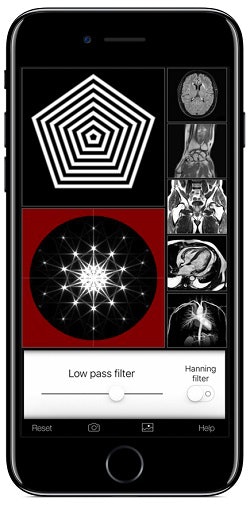 Users can explore the effect of activating the low-pass filter.
Users can explore the effect of activating the low-pass filter.What are the app's most important features?
The app allows you to change MRI scan parameters and immediately see the effect on the corresponding MR image. You can choose one of the clinical cases that come with the app, or any image in your iPhone's photo album. You can also use the iPhone's camera to grab MR images straight from an actual MRI scanner console. Just like its predecessor, the app allows users to set basic parameters such as scan percentage, field-of-view, and half scan; activate high-pass and low-pass filters; and add noise and radiofrequency disturbances.
However, thanks to 20 years of advances in digital technology, the app now also includes parameters for modern MRI methods such as turbo imaging, parallel imaging, and dynamic MR angiography with keyhole acquisition. The performance of the app is impressive; on the latest iPhones it can easily reconstruct over 500 MR images per second at full resolution (256 x 256) so that it can even perform radial and spiral reconstruction of a beating heart -- in real time! Because you can continuously adjust all scan parameters, the app provides a fun and very educational experience.
How many users do you currently have for the app?
The app was released only recently, without any marketing budget, and is currently approaching 1,000 users worldwide. I am convinced it will reach many more users soon.
What are your future plans for the app? Are there any new features or content in the works? Do you have any plans to develop a version for Android?
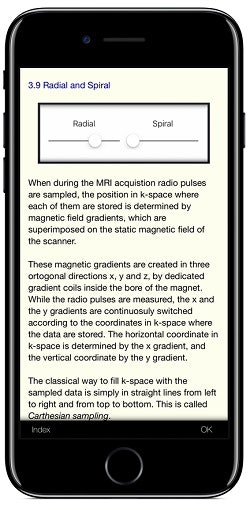 The app can perform radial and spiral reconstruction of a beating heart in real-time.
The app can perform radial and spiral reconstruction of a beating heart in real-time.I think that as a teaching tool the app is already pretty mature in its current form. The camera function is particularly useful as it allows you to create your own album with favorite MR images or geometrical images, which creates a lot of flexibility. One of the next updates will include an extended collection of clinical and geometric images and additional dynamic cases, such as a cardiac MR cine acquisition with a tagging grid.
Maybe I will also implement more advanced MRI techniques, such as motion compensation methods. I can imagine how you could shake your phone to simulate arbitrary patient motion, and then the app could demonstrate how motion compensation techniques such as MultiVane [from Philips] can help reduce image artifacts. Since these are more complex reconstruction methods, I will probably have to integrate the help pages in an interactive way, so that users are actively guided through the story rather than just left alone with it.
Another aspect that is worth exploring is to add MR tissue relaxation dynamics, explaining the T1 and T2/T2* parameters and how you can use repetition time and echo time to manipulate tissue contrasts. With such an addition, the app would basically cover all essentials of MR imaging.
Regarding an Android version, I will not put any effort into that because it was already created by one of my colleagues. The app is called k-Spapp and you can find it on Google Play.
Have you developed any other apps, or do you plan to?
I have created several other apps, most of which have been distributed so far only to a restricted audience. However, it's big fun and I am getting pretty good at it, so rest assured that I will create many more apps in the future. Smartphones have turned into amazingly powerful computers these days, and I am convinced they will drive a whole new era in medical imaging technology, first in education and later also in diagnostics.
A k-Space Odyssey can be downloaded for free from the iTunes Store.




